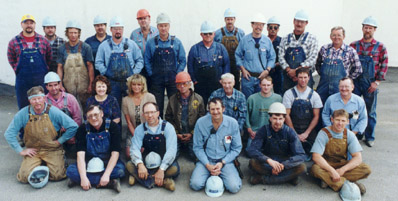|
By Lois Kerr
Dan Rootes, Sidney Holly Sugar's maintenance manager, along with his assistant Curt Olson and an exceptional maintenance crew, works year round to assure the factory equipment stays in good running order. The maintenance department, which includes electricians, welders, mechanics, instrumentation people, oiler/greasers and those who keep the power house operational, oversees every aspect of equipment maintenance and repair. Their hard work allows the production crews to process top quality sugar with a minimum of equipment breakdowns and problems. For winter campaigns, the maintenance department has four crews composed of seven people to handle round-the-clock maintenance checks and repairs. These crews involve themselves directly with the internal sugar extracting equipment. The two mechanics, one electrician, one oiler/greaser, one instrument technician, one welder and one supervisor contained in each of the four crews ensures that the factory has as few stops and shutdowns as possible during the campaign. The maintenance department also has a day crew whose responsibilities rest with the periphery equipment at the factory. As the plant manufactures most of its own machinery parts, this day crew includes two machinists. As well, this crew has one mechanic, one building maintenance technician responsible for maintaining the buildings in good repair, one welder directly involved with outside periphery equipment, and one precision maintenance technician who performs vibration analyses and precision alignment. The maintenance crew also employs a mechanic who keeps all factory vehicles, from forklifts to the locomotive, in proper running condition. Curt Olson, assistant maintenance manager, says that because harvests have become larger and campaigns runs longer, the maintenance crews see more wear and tear on equipment, with correspondingly less time to repair them. For this reason, the maintenance department practices preventative maintenance all winter. "We must work smarter and faster," Olson says. "There's a lot more equipment to maintain than there was in previous years, plus technology has changed so much." Olson explains that the factory used to finish campaign by the end of January or early February, but now campaign continues into March. "The longer campaign gives us less time for making repairs," Olson remarks. "We still need to have all equipment checked and ready by Sept. 1 for the next campaign." During summer months, the crews all move to day shift and work on equipment repair and replacement. "Equipment that we've monitored all winter long we take apart and fix, if necessary," Olson says. "We check every piece of equipment in the factory." Equipment has changed drastically over the years. Sidney's Holly Sugar has moved from some very antiquated equipment to equipment that is ultra-modern, which has enhanced the plant automation. This has resulted in the maintenance crews acquiring more technical skills. "Crew skill levels have increased over the years," Olson comments. "We need electronic and instrumentation technicians, and we need more skilled mechanics, something the factory did not need in earlier years." Olson points out that the factory has gone from no automated equipment to today's computer controlled operation. "We've gone from one extreme to the other," Olson says. "Our maintenance crews today need to understand how the equipment works, and how to trouble shoot. We can't just replace parts anymore. We need to understand the problem and then fix the problem, or trouble will reoccur." With today's technology, maintenance crews have more test equipment available to them which determines the condition of factory equipment. This allow maintenance crews to practice precision maintenance, something crews could not do even ten years ago. "This maintenance program allows us to look closely at alignment of rotating equipment, and to conduct vibration analyses," explains Olson. "These precision measurements allow us to predict failures before the equipment breaks." He continues, "By the old method, we fixed equipment when it broke. Today, we can't afford to do this, so we try to predict failures and take steps to fix potential problems before any breakdown occurs." Changes in materials have also helped equipment last longer with less maintenance, making for more economical operations. "Seventy-five years ago, people used carbon steel," Olson remarks. "Today we have stainless steel and plastics, both of which greatly improve maintenance performance." Olson points out that the beet elevator was originally designed to handle 4,300 tons of beets a day. With recent improvements, the factory has speeded up the overall operation so that today the beet elevator handles 6,000 plus tons of beets per day. "As a result, the guide rails inside the elevator, which were 1/2 inch thick carbon steel, would wear out before campaign had ended, forcing us to totally shut down the beet end of the factory to replace 20- to 30-foot sections of worn out rail," Olson says. To eliminate this problem, maintenance crews installed polyurethane plastic as the wear surface. "The rails did not wear out this year," Olson advises. "The polyurethane did wear some, so we will change over to an even harder plastic for next year." He adds, "Plastics were unheard of 75 years ago. This kind of technology just was not available." The same idea works for couplings. Years ago, couplings were all made from carbon steel. With the advent of plastics, the factory has moved to jawed couplings with plastic insert liners. "The plastic is self-lubricating, and lasts a long time," Olson says. "When the plastic inserts do wear out, we replace them with another $3 plastic insert. When carbon steel wears out, we're looking at a lot more than $3 for replacement costs." "We're just trying to build a better mousetrap," Olson jokes.
|


